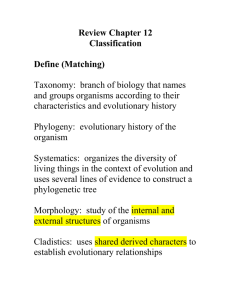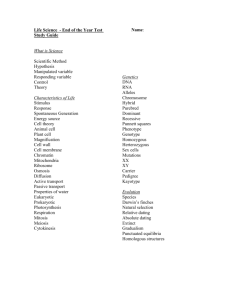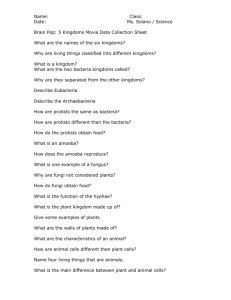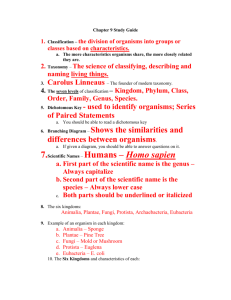SG 4.1 notes - Montgomery's Hedrick Life Science
advertisement
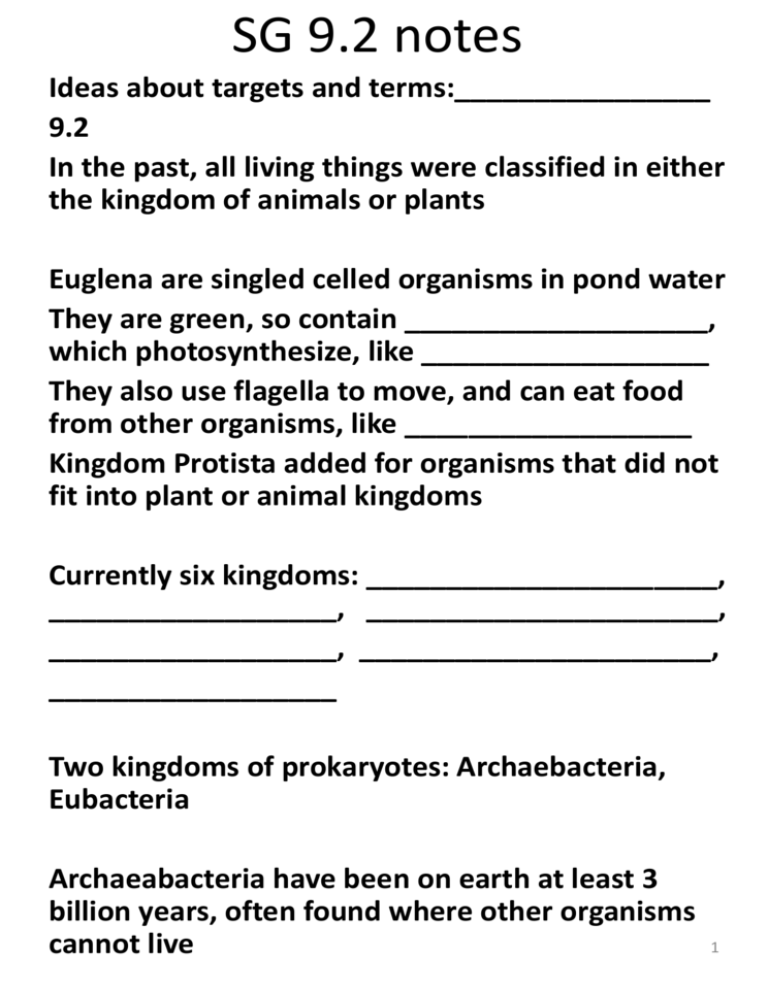
SG 9.2 notes Ideas about targets and terms:________________ 9.2 In the past, all living things were classified in either the kingdom of animals or plants Euglena are singled celled organisms in pond water They are green, so contain ___________________, which photosynthesize, like __________________ They also use flagella to move, and can eat food from other organisms, like __________________ Kingdom Protista added for organisms that did not fit into plant or animal kingdoms Currently six kingdoms: ______________________, __________________, ______________________, __________________, ______________________, __________________ Two kingdoms of prokaryotes: Archaebacteria, Eubacteria Archaeabacteria have been on earth at least 3 billion years, often found where other organisms cannot live 1 SG 9.2 notes Most other prokaryotes are Eubacteria, living in soil, in water, on and inside organisms. Many are helpful to other organisms and many are harmful Protista are unicellular or simple multicellular organisms with eukaryotic cells that do not fit into animal, plant or fungi kingdoms Protists may have evolved from prokaryotes 2 billion years ago, and may be the ancestral eukaryote that evolved into plants, animals and fungi Protozoa- animal like; Algae-plant like; slime molds and water molds-fungus like Plantae are complex multicellular producers Fungi are consumers that break down food outside, then absorb the nutrients 2 SG 9.2 notes Animalia are complex multicellular consumers that lack cell walls. Most animals can move and have nervous systems to sense and react to surroundings 10.1 Bacteria are smallest, simplest and most abundant organisms Bacteria are in two kingdoms: archaeabacteria and eubacteria No nucleus, but do cellular respiration, can move around and reproduce Binary fission is simple cell division: loop of DNA is replicated, both loops attach to cell membrane, as cell membrane grows, DNA separates, cell membrane pinches inward, a new cell wall forms between the two cells Bacteria reproduce best at certain temperatures with a certain amount of moisture Some bacteria survive unfavorable environments by growing thick protective membranes 3 These endospores can survive last millions of years SG 9.2 notes These endospores can survive extreme conditions for millions of years, then break open and grow when conditions are favorable Most bacteria have a rigid cell wall outside membrane that provides shape: Bacilli are rod-shapes, which absorb nutrients well, but dry out easily Cocci are spherical and resist drying out Spirilla are uncommon, long spirals that move easily with flagella on both ends Flagella spin like corkscrews, moving bacteria through liquid Kingdom Eubacteria has more organisms that any other kingdoms Most eubacteria are consumers, some of these are decomposers, and others are parasites Some of the producers use photosynthesiscyanobacteria may be ancestors of chloroplasts 4 SG 9.2 notes Archaebacteria live where no other life can survivehot springs, thermal vents on seafloor, under 400m of ice and 8km below earth’s surface DNA in Archaeabacteria is different from all Eubacteria, not all have cell walls, cell walls are different from Eubacteria 3 main types of archaeabacteria: Methanogens- release methane (natural gas), found in many wet areas like swamps Thermophiles- thermal vents on seafloor, volcanoes, hot springs Halophiles- live in very salty places, like Dead Sea 11.1 (244-246) Protista are eukaryotic- have nucleus Most unicellular, some multicellular Other eukaryotes probably evolved from protist ancestors Producers and consumers 5 SG 9.2 notes Fungus-like protists release digestive juices onto food, then absorb nutrients Slime molds are unicellular and grow in moist areas in colonies, form groups with many nuclei and shared cytoplasm, reproduce by spores Water molds are mostly small and unicellular, some are decomposers, but many are parasites of living host plants, animals or fungi Plantlike protists are producers using photosynthesis- algae, most live in water, all have chlorophyll, but also other pigments, some are multicellular-kelps 250 Animal-like protists are unicellular consumers called protozoa, some are parasites, many can move Grouped into amoeba-like protists, flagellates, ciliates, spore forming protists 6 SG 9.2 notes Amoebas live in soil, in water and as parasites in animals, have contractile vacuoles to move water out, move by extending cell membrane – pseudopodia, engulf food (larger version of endocytosis) and release waste by exocytosis 255-256 Fungi are eukaryotic consumers Live on or near food source, release digestive juices onto food, then absorb nutrients Many are decomposers, some are parasites, others are symbiotic – mycorrhizae grow on plant roots and help roots gather water and minerals while using sugar from plant Some unicellular- yeasts, but most are multicellular Hyphae are chains of cells that form long filaments sharing cytoplasm Mycelium are groups of hyphae that form the body of multicellular fungi Sexual and asexual reproduction by thick-walled spores 7 SG 9.2 notes 261 Lichen is a symbiotic association of a fungus and a photosynthetic partner Fungus form body of lichen, photosynthetic partner lives in body producing sugars for both, fungus protects producers from drying out, gathers water and minerals, and allows it to collect light energy Lichens grow almost everywhere on land, even in dry deserts and Antartica Symbiosis means lichen only need light, air with moisture and minerals in it, so they do not have roots into the growing surface Break down rocks as they grow on them, producing soil Sensitive to air pollution since all water and minerals come from air 8 SG 9.2 notes 12.1 Life as we know it would be impossible without plants Plants make their own food in chloroplasts, using photosynthesis Plants have a waxy cuticle that keeps water inside the plant on dry land Plant have a cellulose cell wall which supports and protects the cells and tissues, some cells develop a secondary cell wall when they are full size Plants reproduce with spores and sex cells in the two parts of their life cycle: the sporophyte stage produces spores, the gametophyte stage produces egg and sperm cells (gametes) Spores grow directly into new plants, sex cells must join together in fertilization to create a zygote (fertilized egg) that grows into a new plant Female Gametophyte Female spores Male Gametophyte Male spores meiosis Sporophyte zygote sperm cell egg 9 SG 9.2 notes 440 million years ago no plants lived on land Plants and green algae (Protista) have the same chlorophyll and similar cell walls, they both store energy in long carbohydrates called starch, they both have gametophyte and sporophyte stages This evidence suggests plants evolved from green algae Plants are classified by characteristics: Nonvascular Vascular- vascular tissue no seeds- reproduce by spores seeds- develop from spores flowering non-flowering SG 9.2 notes 14.1 Over 1 million species of animals grouped into about 35 phyla and classes (smaller groups in kingdom) Animals with skull and backbone are vertebrates: fishes, amphibians, reptiles, birds and mammals Most animals are invertebrates (no backbones): insects, snails, jellyfish and worms (over ¼ of animals are species of beetles) Calculate the percentage of species in each of the groups in figure 3 (add up all to get total # species, then divide group # species by total): Beetles: Ants, bees and wasps: Moths and butteflies: Other insects: Spiders and non-insect arthropods: Jellyfish: Other vertebrates: Mammals: Sponges: Worms: Mollusks: Other invertebrates: Bugs: SG 9.2 notes Animal characteristics: multicellular eukaryotes without cell walls usually reproduce sexually when egg and sperm combine Fertilized eggs develop into embryos Specialized cells organized into tissues, most animals have organs Most animals move, and are capable of moving quickly in a single direction Animals are consumers

